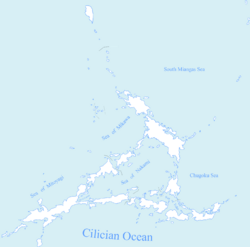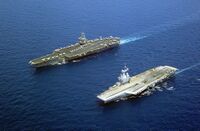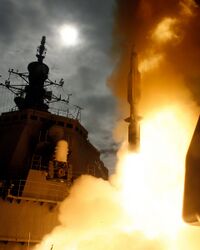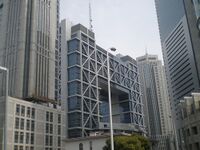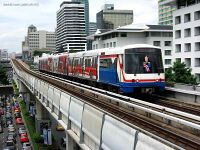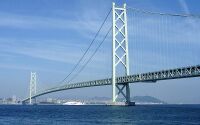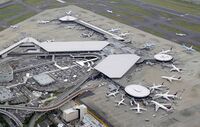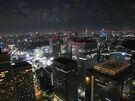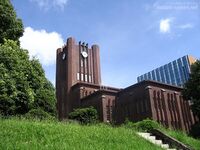Teiko
| Socialist Republic of Teiko 帝光
|
||||||
|---|---|---|---|---|---|---|
|
||||||
| Motto: Ad Meliora. Pro patria, pro populo, pro mundi. | ||||||
| Anthem: "Teiko. Land of Promise." Sanese: 帝光約束の地 |
||||||
Teiko's 10 Major Regions
|
||||||
| Capital | Tetsuya | |||||
| Largest city | Teiko Metropolitan Area | |||||
| Official languages | Sanese | |||||
| Recognised national languages | Sanese and Trentannian | |||||
| Recognised regional languages | Teikonese; Kwangju | |||||
| Ethnic groups | Beikanese, Junichese, Kaijonese, Kamatean, Nakian, Rakunean, Seirinian | |||||
| Demonym | Teikonian | |||||
| Government | Unitary Parliamentary Constitutional Republic | |||||
| - | Premier | Seijuro Akashi | ||||
| - | Vice Premier | Vacant | ||||
| - | Sandaedeung | Fukui Kensuke | ||||
| - | Chief Justice | Shinichi Kudo | ||||
| Legislature | Teiko National Council (Central-46) | |||||
| Independence TBA | ||||||
| - | TBA | TBA | ||||
| - | TBA | TBA | ||||
| Area | ||||||
| - | Total | 100,210 km2 38,690 sq mi |
||||
| Population | ||||||
| - | 2012 estimate | 72,256,983 | ||||
| - | Density | 721.05/km2 1,867.59/sq mi |
||||
| GDP (PPP) | 2013 estimate | |||||
| - | Total | 2.26 Trillion Zen ($1.56 Trillion) | ||||
| - | Per capita | 31,281.67 Zen ($21,584.35) | ||||
| HDI (2012) | .845 very high |
|||||
| Currency | Teikonian Zen (TNZ) |
|||||
| Drives on the | right | |||||
| Calling code | +691 | |||||
| Internet TLD | .tk | |||||
Teikō (帝光 Teikou), officially known as the Socialist Republic of Teikō, is a sovereign island country located at Eastern Althena bordered by the Imperial Kingdom of Okaiken in the west, State of Nakahara in the north and Cilician Ocean in the east. The central government of Teikō which has its seat in the capital of Tetsuya Special Administrative Region currently exercises jurisdictions over four regions (Beika, Seirin, Rakuzan and Teiko), three autonomous divisions (Hanji, Kitakana and Johto) and three mostly self-governing special administrative states (Fukuyama, Takezaki and Tetsuya).
Teikō is an archipelago of 1,945 islands covering approximately at least 100,526 sq. kilometers (36,064.11 sq. miles).The five largest islands are Hayama, Eikichi, Mibuchi, Teppei and Makoto which together constitutes 90% of Teikō’s total area. Teikō has an estimated population of 73 Million people making it on the most densely populated countries in the world. Teikō Metropolitan Area is considered to be one of the world’s largest urban agglomerations with over 24 million residents. The characters that make up Teiko’s name means “sovereign light”, which is why Teikō is sometimes referred to as the “Light of the Orient”. Teikō is one of the three major Sanese speaking countries in Adonia.
The history of Teikō goes back to prehistoric times during the arrival of the Adi Man from mainland Althena through land bridges.
Between (date) and 1993, Teiko's tiger economy grew at an average of 10% annually, fueled by annual export growth of 20%, in a period called the (Miracle on Ao River) that rapidly transformed it into a high-income advanced economy and the world's 11th largest economy by 1994. Today, Teiko is the seventh largest country in international trade and a founding country of the Adonia Economic Forum. Teiko ranked 12th in the Human Development Index. It also ranks highly in education, quality of health care, rule of law, ease of doing business, government transparency, job security, tolerance and inclusion. Although Teiko is a socialist country in terms of economics, its politics remains largely democratically liberal.
Etymology
Teiko was named by a () explorer named (name) who first reached the Kitakana islands on (). The named Teiko which has its roots from the Kanji 帝 (Mikado) and 光 (Hikari) literally means sovereign light. (name) described his glorious encounters with the gods in his journal named (journal name) which was refurnished in 1986. Eventually the name Teiko would be used to cover all the islands of the archipelago. Before that became commonplace, other names such as Doppo, Shinya and Etedo were used.
The official name of Teiko has changed several times in the course of the country's history. During the Teiko Revolution, the Iwatomo Congress proclaimed the establishment of the Teiko Republic. From the period of the (), the country is referred to as the Teiko Islands. From the (), the name Teiko began to appear and it has since become the country's common name. Since the end of Great Adonian War, the official name of the country has been the Republic of Teiko. In 1995 after a constitutional crises, the name was finally changed to its present form, Socialist Republic of Teiko.
History
Main article: History of Teiko
Prehistory
Miyagi Empire
86 Year Clan War
Heian Period
Mito Period
Jimmu Period
Kitayama Period
Sengoku Period
Taiju War
Unification Attempt by Ogasawara Terumasa
Rise of the Taiga Shogunate
Taiga Shogunate
Akashi Restoration
Great Adonian War (GAW)
Post GAW History
Teiko suffered greatly from the destruction caused after the Great Adonian War.
1994 Constitutional Crisis
Contemporary History
Government and Politics
Main articles: Government of Teiko and Politics of Teiko
The Government of Teiko is the unitary government of the Socialist Republic of Teiko. Teiko has been a constitutional republic under a unitary parliamentary system since ___ (during its independence). The country has existed in some form prior to its independence, but the country emerged as a modern nation state after the foundation of the (NAME) Dynasty and the city of Teiko in (date). The Revolution of (date) brought an end to the absolute monarchy and replaced it with a system of constitutional republic. Since then, despite having 17 constitutions, the form of government has remained the same and the current administration follows the Teiko Constitution of 1995. Power is chiefly held by the Teiko Premier and other elected members of the Central-46 while the while sovereignty is vested in the Teikonian people. All the government offices are located within Tetsuya, the capital city of Teiko.
Teiko's legislative organ is the Teiko National Council which is colloquially called Central-46, a unicameral parliament headed by a Sandaedeung. The Central-46 consists of 460 prefectural representatives voted every six years or when dissolved. There is universal suffrage for adults over 18 years of age, with a secret ballot for all elected offices. The Central-46 is dominated by the social liberal Democratic Party of Teiko (DPT) and the socialistic Teiko National Party (TNP). The TNP has enjoyed near continuous electoral success since 1977, except for a brief 6 month period in 1994 during the 1994 Teiko Constitutional Crises, and from 2001 to 2007 and again in 2013. As of the 2013 council, it holds 231 seats while the DPT holds 124 seats.
The Sandaedeung is the head and the presiding officer of the Central-46. He is considered to be the head of the legislative branch. He has overall charge of the administration of the Central-46 and its secretariat and presides over all parliamentary sittings. The sandaedeung is third in line of the premier succession after the vice premier. The sandaedeung is not necessarily from the majority party and is elected also through the first session of incoming Central-46 Congress. The current sandaedeung is Fukui Kensuke.

The Teiko Premier is the head of government and state is elected by the people via the Electoral College, a virtual number of official votes per prefecture which is equal to their number of representatives. The constitution dictates that only current members of the Central-46 premier shall be eligible to run for the office. The Premier is the head of the Cabinet, and he appoints justices of the Supreme Court of Teiko and commissioners of the different constitutional commissions with approval of the national council. It doesn't follow that the candidate of the majority party will automatically be elected as Teiko Premier. The current premier is Seijuro Akashi who won the 2009 Teiko National Elections via landslide and was inaugurated as the _th Premier of Teiko on January 30, 2010.
The Supreme Court of Teiko is the highest judicial body in Teiko. The Supreme Court is headed by the Chief Justice of Teiko and 5 Associate Justices. The Supreme Court has jurisdiction over cases involving fundamental rights. It has the power both to declare the law and to strike down union or state laws which contravene the constitution. The Supreme Court is also the ultimate interpreter of the constitution. All justices are given lifetime tenure unless otherwise removed from power by the Blue Ribbon Committee. Shinichi Kudo, the current chief justice has been in his position since his appointment in 2001.
Political Parties
In 2012 there are 3 major political parties in Teiko, namely, the Democratic Party of Teiko (DPT), the Teiko National Party (TNP) and the Teiko Liberal Party (TLP). Although each party differ in advocacies, the constitution explicitly implies that all political parties must adhere to the socialistic paradigm of government and economic policies as defined by the Teiko Constitution of 1995. This was the compromise reached during the 1994 Teiko Constitutional Crises where in heated arguments and stand-offs nearly dissolved the national council. Such policy received many criticism from foreign and national critics. Former Teiko Premier, Izaya Orihara mentioned that "They [government] say they are giving people a more democratic option but from what I can see is that they are just trying to hide their enthusiasm of creating a single-party nation.... They give better options by giving people opportunity to create parties but their advocacies are limited to socialism, this is a joke.". As of 2013, there has never been a motion to change the policy and most of the Teikonians embrace socialism as part of their daily life.
Elections
With the current status of the government of Teiko, it has two elections which occurs alternately every three years, national elections and general elections. The general elections are held midway through the tenure of the Teiko Premier. Both the general and national elections includes local and prefectural elections, the national elections however also includes election of the premier and the vice-premier among the incumbent prefectural representatives. Elections are supervised by the local Commission on Elections (Comelec) at each administrative level under the general direction of the national Comelec. The Comelec is among the few constitutional chartered committees that serves under the premier directly without being under any ministry.
Administrative Divisions
Further information: Prefectures of Teiko, Regions of Teiko, Cities of Teiko, Towns of Teiko and Villages of Teiko
The Socialist Republic of Teiko has administrative control over four regions (Beika, Seirin, Rakuzan and Teiko), three autonomous divisions (Hanji, Kitakana and Johto) and three mostly self-governing special administrative states (Fukuyama, Takezaki and Tetsuya). However, these regions do not exercise official administrative functions but is used traditionally in a number of contexts. The ten major regions are further divided to 38 prefectures. Each prefecture is overseen by an elected governor, legislature and administrative bureaucracy. Each prefecture is further divided into cities, towns and villages.
| Namea | Sanese | Populationc | |||||||||||||||||||
|---|---|---|---|---|---|---|---|---|---|---|---|---|---|---|---|---|---|---|---|---|---|
| Ten Major Regions of Teikoa | |||||||||||||||||||||
| Teiko | 강원도 | 1,542,263 | |||||||||||||||||||
| Beika | 충청북도 | 1,572,732 | |||||||||||||||||||
| Seirin | 충청남도 | 2,047,631 | |||||||||||||||||||
| Rakuzan | 전라북도 | 1,872,965 | |||||||||||||||||||
| Johto | 전라남도 | 1,907,172 | |||||||||||||||||||
| Kitakana | 경상북도 | 2,699,440 | |||||||||||||||||||
| Hanji | 경상남도 | 3,333,820 | |||||||||||||||||||
| Fukuyama | 경상남도 | 3,333,820 | |||||||||||||||||||
| Takezaki | 경상남도 | 3,333,820 | |||||||||||||||||||
| Tetsuya | 경상남도 | 3,333,820 | |||||||||||||||||||
Security and Defense
Main articles: Teiko National Military. Ministry of Defense
A long history of civil unrests and internal invasions by militarized militants have prompted Teiko to allocate 15% of all government spending to its military, while maintaining compulsory conscription for men. Consequently, Teiko has the world's fifth largest number of active troops (500,000 in 2011),the world's second-largest number of reserve troops (1,000,000 in 2011) and the eleventh largest defense budget. The Socialist Republic of Teiko, with both regular and reserve military force numbering 1.5 million regular personnel among a total national population of 72 million people, has one of the highest number of soldiers per capita in the world.
The Teiko military is arguably the one of the most technologically advanced in Eastern Althena. It comprises the Teiko National Army (TNA), Teiko National Navy (TNN), Teiko National Air Force (TNAF) and the Teiko National Marine Corps (TNMC). Many of these forces are concentrated near the Beika Prefecture and three autonomous states of Hanji, Kitakana and Johto. It is seen as the guarantor of the country's independence, peace and order. The nation's philosophy of defense is one of diplomacy and deterrence. This principle translates into the culture, involving all citizens in the country's defense. Thus, all Teikonian males are constitutionally required to serve in the military, typically 21 months or more. Previously, Teikonians of mixed race were exempt from military duty but the exception was lifted in 2010.
The Teiko army has 1,500 tanks in operation, including the K1A1 and K2 Black Panther, which form the backbone of the Teikonian army's mechanized armor and infantry forces. A sizable arsenal of many artillery systems, including 1,700 self-propelled K55 and K9 Thunder howitzers and 680 helicopters and UAVs of numerous types, are assembled to provide additional fire, reconnaissance, and logistics support.
The Teikonian navy has made its first major transformation into a blue-water navy through the formation of the Strategic Mobile Fleet, which includes a battle group of Chungmugong Yi Sun-sin class destroyers, Dokdo class amphibious assault ship, AIP-driven Type 214 submarines, and King Sejong the Great class destroyers, which is equipped with the latest baseline of Aegis fleet-defense system that allows the ships to track and destroy multiple cruise missiles and ballistic missiles simultaneously, forming an integral part of Teiko's indigenous missile defense umbrella.
The Teikonian air force operates 540 aircraft, making it world's ninth largest air force, including several types of advanced fighters like F-15K, heavily modified KF-16C/D,and the indigenous F/A-50, supported by well-maintained fleets of older fighters such as F-4E and KF-5E/F that still effectively serve the air force alongside the more modern aircraft. In an attempt to gain strength in terms of not just numbers but also modernity, the commissioning of four Boeing 737 AEW&C aircraft, under Project Peace Eye for centralized intelligence gathering and analysis on a modern battlefield, will enhance the fighters' and other support aircraft's ability to perform their missions with awareness and precision.
From time to time, Teiko has sent its troops overseas to assist in relief operations. It has also sent a considerable amount of forces in Bergenstein to help assist in the peace keeping operations during the Bergen Wars. However, it quickly recalled its army due to internal conflicts and pressure from the international community.
Foreign Relations
Main articles: Foreign Relations of Teiko, Teiko Foreign Policy
Teiko's relationship with other countries have varied greatly with different periods in its course of history. Due to its complicated internal political and economic structure, Teiko has limited appearance in international organizations. However, Premier Akashi's foreign and economic policies have paved way for externalization of Teikonian efforts. As of 2013, Teiko maintains diplomatic relationships with 180 nations and operates embassies and consulates in 169 countries. In 2014, Teiko was accepted as an official member of the United Sovereign Nations which the Central-46 have unanimously ratified after rigorous debates. Teiko is also a member of other organizations such as WTO, East Althenian Sphere (EAS), G-20 major economies, World Bank, and IMF. It also hosts the annual Adonia Economic Forum (AEF).
In 2011, Teiko launched Teiko International Cooperation Agency (TICA) which was designed to further boost relations between Teiko and the international bodies through culture exchange programs, infrastructure developments, relief operation and such. Currently, TICA has major activities in the planing of the East Althenia high speed rail which will connect the three Sanese speaking countries, Nakahara, Okaiken, Teiko and the country of Kwangju.
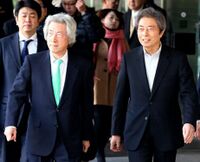
Okaiken
Historically, Teiko-Okaiken relationship have fluctuated greatly during the Akashi Restoration until the present. This is due to the internal lock-down of Teiko from foreign relations during the restoration period and the aftermath of the Great Adonian War. As of 2013, Teiko operates its embassy in Okaiken maintaining diplomatic relationships between the two countries. The current government of Teiko has also been promoting better relationships with Okaiken through the creation of the Sanese Triangle, an alliance between Nakahara, Okaiken and Teiko.
Nakahara
Shayden
Shayden and Teiko have been important trading partners after the Great Adonian War. Majority of the the Shayden products that enters the East and Central Althena enters Teiko first as a major gateway to the continent. Shayden and Teiko maintains close economic ties while avoiding political confrontations. There are many Shayden corporations operating in Teiko mostly in the technology and electronic industry.
Kwangju
Sundanesia
Abbasid
Bergenstein
Teiko have maintained close diplomatic and economic relationships with Bergenstein until the outbreak of the Bergen Wars in August 2013. In lined with the growing chaos, all Teiko offices in Bergenstein have been closed and all Teikonians living in the country have been evacuated. Travel issues have also been released. In June 2014, Teiko have sent military forces in Bergenstein with the request of the current chancellor but recalled it immediately due to international pressure and internal problems. As of the moment, relationship with Bergenstein has been closed until further notice.
Pelian
Sinope
Geography
Climate
Biodiversity
Environment
Economy
Main article: Economy of Teiko
The national economy of Teiko is the one of the largest in the world, with an estimated 2013 gross domestic product (PPP) of $1.56 trillion. Primary exports include semiconductors and electronic products, transport equipment, garments, copper products, petroleum products, coconut oil, and fruits. Major trading partners include the Okaiken. Sundanesia, Kwangju, Shayden, Nanami, Abbasid and Sinope. Its unit of currency is the Teikonian Zen (Z or TNZ). Teiko is classified as a middle power by many financial and political organizations.
A newly industrialized country, the Teiko economy has experienced rapid transition from one based on agriculture to one based more on services and manufacturing. As of 2013, of the country's total labor force of around 44.813 Million, the agricultural sector employs close to 18% and contributes to only about 14% of GDP. The industrial sector employs around 35% of the workforce and accounts for 30% of GDP. Meanwhile the 47% of workers involved in the services sector are responsible for 56% of GDP.
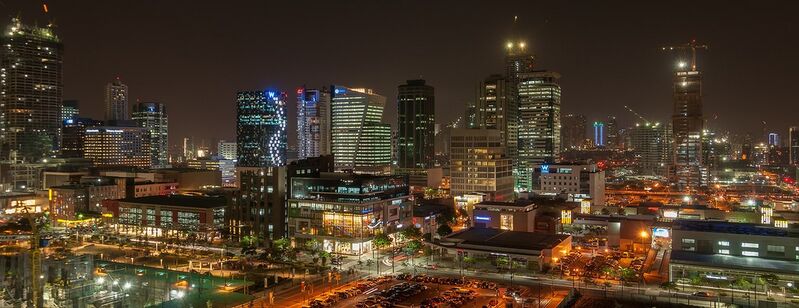
Teiko's economy was one of the world's fastest-growing from the early (date) to the late 1990s, and Teiko is still one of the fastest-growing developed countries in the 2000s, along with Okaiken, Nanami, and Kwangju, the other three East Altheian Tigers. Teikonians refer to this growth as the Miracle on the Ao River. The Teiko economy is heavily dependent on international trade and finance, and in 2010, Teiko was the sixth largest exporter and tenth largest importer in the world. Teiko, due its geographic location is a natural gateway for exports coming from Itzamna and Euphemia.
Teiko hosted its first Teiko Economic Forum in Hanjin Hotel, Beika City on May 2014. The two-day summit was expected to boost Teiko's economy by 31 trillion zen, or 4% of Teiko's 2014 GDP, in economic effects, and create over 160,000 jobs in Teiko. It may also help improve the country's sovereign credit rating and will help further establish itself a major trading center in Adonia.
Despite the Teiko economy's high growth potential and apparent structural stability, the country suffers damage to its credit rating in the stock market because of internal issues with territorial disputes between the three regions of Hanji, Kitakana and Johto where in cultural differences have caused major prejudices between each areas. Teiko, despite opening its market towards a more free enterprise still exercises socialistic practices in regards with basic needs such as utilities and food. Teiko have strict laws in the conduction of local and even foreign businesses. Majority of the corporations operating in Teiko are also being scrutinized by the Accounting and Corporate Regulatory Authority. Some government policies also limits the influence of independent business organizations and cooperatives in the country. All these factors as noted by the financial magazine,Onodera pose a huge threat to the booming economy. Although it was severely harmed by the Teiko economic crisis of the late 1995, the Teiko economy managed a rapid recovery and subsequently tripled its GDP.
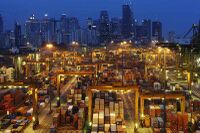
Other incongruities and challenges exist aside from strict government regulations and territorial disputes. The economy is heavily reliant on international trade and it has problems with attracting foreign investors which hinders the inflow of foreign currency in the country. Regional development is uneven with Teiko and Rakuzan gaining most of the new economic growth - more than half of the country's total GDP - at the expense of the other regions, although the government has taken steps to distribute economic growth by promoting investment in other areas of the country. Despite constraints, service industries such as tourism and business process outsourcing have been identified as areas with some of the best opportunities for growth for the country. Teiko is also now starting to diversify to manufacturing as more production corporations offer to construct their factories in the country.
Adex Credit Rating rates the country with an "A" credit rating and Arashi and Kanjani includes the country in its list of the best countries for investments. Arashi and Kanjani also estimates that by the year 2025, Teiko will be the in the top 5 largest economy in the world. Teiko is home to the Adonia Economic Forum and Teiko National Stock Exchange, one of the largest stock markets by market capitalization. It is also a member of the World Bank, the International Monetary Fund, the World Trade Organization (WTO), the Althena Development Bank and the East Althenian Sphere among other groups and institutions.
Infrastructure
Section article: List of tallest structures in Teiko
Energy
Main article: Energy in Teiko
As of 2011, 80.9 percent of energy in Teiko was produced from nuclear, 11.3 percent from coal and the remaining percent from natural gas, solar energy, petroleum and hydropower. The Teiko government has always favored the use of nuclear as the main source of energy. However following the potential meltdown of Dojishima Nuclear Power Plant after a plant failure which released an undisclosed amount of radioactive materials in the atmosphere, public debates spark as opposition grew against nuclear energy. The government however remained in favor of the use of the technology and in response created a more strict protocols in the standard operating procedures of all power plants in the country. Tsuji Montaro, Minister for Utilities has announced in the Teiko Economic Forum that the government will provide efforts to diversify its sources while maintain high levels of energy efficiency. As of 2014, all of the 15 running nuclear power plants in Teiko and the Atarashi Nuclear Power Plant in Atarashi, Seirin is the largest nuclear power plant in Adonia generating an estimate of 10,000 MW are online.
Transportation
Main article: Transportation in Teiko
Teiko has a fairly technologically advanced transport network consisting of high-speed railways, highways, bus routes, ferry services, and air routes that criss-cross the islands of the country. The Ministry of Transportation through Teiko Expressway and Tollways Corporation operates the toll highways and service amenities en route. As of 2014, there are four major inter-prefecture expressways in the country, Teiko Interstate, Teiko National Circumferential Expressway and Rakuzan-Teiko Expressway (RTE), Seirin-Beika-Takezaki Expressway (SCTAX)
Teiko National Railways Corporation provides frequent train services to all major Teiko cities and municipalities. Plans for a high speed rail connecting Teiko to its neighboring countries of Nakahara and Okaiken are now under study. The Teiko high-speed rail system project which will connect the islands of Mibuchi and Hayama are also being constructed with the help of Abbasid and Kwangju. The carriages will be purchased from Bruellen. The new line will also feature an underwater tunnel crossing the Ichigo Channel. Major cities including Teiko, Rakuzan, Aokuro, Beika, Hamada and Seirin have mass complex transit systems urban which includes rapid transit systems, rapid bus transit systems and subways. Express bus terminals are available in most cities.
Teiko's largest airport, Akashi International Airport (AIA) which is named in honor of the Akashi clan during the Akashi Restoration, was completed in 2001. By 2007, it was serving 39 million passengers a year as one of the major international gateway to Teiko. AIA is one of the three major airports serving the Teiko Metropolitan Area with the other two being the Imada International Airport and Miyazaki Domestic Airport. Other major international airports include Rakuzan, Seirin and Beika. There are also twenty-two domestic airports, and a large number of heliports.
Teiko Airways, founded in 1954 is one of the oldest airways in the world and have served 29,640,000 passengers, including 16,490,000 international passengers in 2008. A second carrier, Oceanic Airlines, established in 1988, also serves domestic and international traffic. Combined, all of Teikonian major airlines serve 297 international routes. Smaller airlines, such as Kiyoshi Air, provide domestic service with lower fares. Air travel is a common and favored way of traveling in Teiko as some airlines often provide promos in irregular basis.
As an archipelago, inter-island travel via watercraft is often necessary. The busiest seaports are Teiko, Rakuzan, Aokuro, Hamada, Beika and Aokise. Aokuro ranks as the busiest in seaport by tonnage handled in 2013 while Teiko ranks as the busiest port via passenger volume. Passenger ships and other sea vessels such as those operated by 2GO Travel and Teiko Lines serve Teiko City, with links to various cities and towns. In 2003, the 919-kilometer (571 mi) Strong Republic Nautical Highway (SRNH), an integrated set of highway segments and ferry routes covering 17 cities was established. Some rivers that pass through metropolitan areas, such as the Kuro River and Ao River, have air-conditioned commuter ferries. The Kuroko River Ferry Service which traverses the symbolic Kuroko River has numerous stops in the different wards of Teiko Metropolitan Area and Tetsuya.
Communications
Main article: Communications in Teiko
Teiko has a sophisticated telecommunications industry and a high concentration of users. There is only one national Internet and telecommunications provider in Teiko, Teiko National Telecommunications Corporation which is under the Ministry of Internal and External Communications (MICE). However there are also other local-scale service providers but are far more expensive. Also, all Teikonians are mandated by law to have cellular phones. Teikonians don't pay for service directly but are taken from the tax collected from them annually which is referred to as the the Telecommunications Service Tax. Each Teikonian have a corresponding national cellular code which is unique and can be compared to the national card number. However, there are exceptions to this rule which is determined by the MICE.
As a result, text messaging is a popular form of communication, and in 2013, the nation sent an average of one billion SMS messages per day. Over forty-five million mobile phone users also use their phones as virtual wallets, making it a leader among developed nations in providing financial transactions over cellular networks. The Teiko National Telecommunications commonly known as TNTC is also categorized as a semi-public corporation and is listed in the Teiko National Stock Exchange. It is also one of the largest company in the country. Estimates for Internet penetration in Teiko is estimated at 65 million. Teiko also boasts one of the fastest Internet connection in the world at 34 Mbps. Social networking and watching videos are among the most frequent Internet activities.
Science and Technology
Tourism
Demographics
Main article: Demographics of Teiko
Population
Teiko's population is estimated at around 72.3 million, with 80% of the population living in the urban areas of the country in the islands of Mibuchi and Makoto. Teikonian society is linguistically and culturally homogeneous, composed of 85.5% ethnic Teikonian, with small populations of foreign workers and other minor ethnic groups. People from Kwangju, Okaiken, Nakahara, Pelian and Sundanesia are among the small minority groups in Teiko. In 2012, there is an estimate of 1.5 million Kwangju people, making it the largest Kwangju diaspora in the world.
Teiko has one of the longest overall life expectancy at birth of any country in the world: 71.5 years for persons born in the period 2010–2015. The population of Teiko continues to grow at an annual rate of 3.14% from 2001-2011 and is expected to hit the 100 million benchmark on 2030. The population median age is 32.6. There is an estimate of 8 million Teikonians living outside Teiko creating one of the largest diaspora in the world.
Teiko suffers from a high suicide rate. In 2010, the number of suicides exceeded 25,000 for the twelfth straight year. Suicide is the leading cause of death for people under 30 and is the sixth leading cause of death in the country in general.
Ethnicity
There four legally recognized ethnic groups in Teiko, Teikonian, Rakunean, Seirinan and Beikanese.
Religion
Teiko enjoys full religious freedom based on Article 20 of its Constitution. Despite this majority of the people in Teiko are unbelievers. In the most recent surveys, around 72 percent of the Teikonian population do not consider themselves believers in any religion. The biggest religion in Teiko however are Buddhism and Shintoism which accounts 80 percent of the total religionists in Teiko.
Nevertheless, the level of participation remains high, especially during festivals and occasions such as the first shrine visit of the New Year. Taoism and Confucianism from Peilan have also influenced Teikonian beliefs and customs. Teikonian streets are decorated on Tanabata, Obon and Christmas. Fewer than five percent of Teikonians are Christian. Other minority religions include Islam, Hinduism, Sikhism, and Judaism, and since the mid-19th century numerous new religious movements have emerged in Teiko.
Language
Sanese has always been the national language of Teiko, more than 99 percent of the population speaks it as their first language. Sanese is an agglutinative language distinguished by a system of honorifics reflecting the hierarchical nature of the Sanese society, with verb forms and particular vocabulary indicating the relative status of speaker and listener. Sanese writing uses kanji (Peilanese characters) and two sets of kana (syllabaries based on simplified Peilianese characters), as well as the Latin alphabet and Arabic numerals.
Aside from Sanese, Teikonese is also an important dialect mostly spoken from people living in the islands of Hayama and Makoto. There are around 14 major dialects in Teiko which forms the Teikonese-Sanese language family. Among the three Sanese speaking countries, Teiko has the most diversified language which is mainly due to Western influences and preservation of local dialects. In the recent years, the Teiko government has also been promoting the use of Trentannian as a major language especially when dealing wither international relations. Most public and private schools require students to take courses in both Sanese, Teikonese and Trentannian.
Cities
Main article: List of Cities in Teiko
A city is local administrative unit of Teikō. Cities are ranked on the same level as towns and villages, with the difference that they are not component of the district. Like any other administrative units, cities are defined by the Teiko Constitution of 1995.
City Status
Article 10, Section 5 of the Teiko Constitution of 1995 sets the the following conditions for a municipality to be designated as a city:
- Population must be at least at 50,000 or greater
- At least 60% of the household must be established in a central urban area
- At least 60% of the household must be employed in commerce, industry or other urban occupations as designated by the Ministry of Interior and District Government.
- Any other ordinance set by the prefectural ordinance must be satisfied.
The designation will be approved by the prefectural governor and the minister of interior and district government.
A city can be theoretically demoted into a town or village when it fails to meet any of the following conditions stated above, but such demotion has not yet occurred.
Classification for large cities
The Cabinet of Teiko can designate a city of at least 200,000 inhabitants to have the status of a special city, core city or designated city. These statuses expand the scope of administrative authority designated from the prefectural government to the city government.
Status of Teiko
Teiko City, Teiko's capital existed as singe core city since 2001 but it now legally classified as a special type of prefecture called metropolis. The 18 special wards of Teiko which constitutes the core of Teiko Metropolitan Area, each have an administrative status analogous to that of a city. Teiko also have some incorporated cities, towns and villages within its jurisdictions.
List of Largest Metropolitan Areas
| Largest Metropolitan Areas in Teiko | ||||||||||
|---|---|---|---|---|---|---|---|---|---|---|
| Rank | Core city | Prefecture | Metropolitan Area | Population (2024) | Region | |||||
| 1 | Teiko | Teiko | Teiko Metropolitan Area | 24,234,728 | Teiko | |||||
| 2 | Rakuzan | Makoto Prefecture | Rakuzan Metropolitan Area | 11,356,474 | Rakuzan | |||||
| 3 | Seirin | Dojimazaki Prefecture | Seirin Metropolitan Area | 5,946,326 | Seirin | |||||
| 4 | Aokuro | Kamata Prefecture | Aokuro Special Administrative Area | 3,460,362 | Teiko | |||||
| 5 | Beika | Chiwa Prefecture | Greater Beika | 2,753,890 | Beika | |||||
| 6 | Kiyohana | Kojiro Prefecture | Kiyohana Metropolitan Area | 2,459,812 | Rakuzan | |||||
| 7 | Morizuki | Too Prefecture | Morizuki Area | 2,395,591 | Teiko | |||||
| 8 | Akamayu | Kotaro Prefecture | Akamayu Metropolitan Area | 2,192,982 | Rakuzan | |||||
| 9 | Aokise | Kaijo Prefecture | Aokise Area | 2,104,257 | Teiko | |||||
| 10 | Hamada | Inoue Prefecture | Greater Hamada Area | 2,094,256 | Beika | |||||
Nearly 80% of all Teikonians live in urban areas. Majority of them lives in the Kiseki no Kaigan (Coast of Miracles) which is colloquially called as the Kiseigan Belt. It is the name for the megalopolis in Teiko extending from Kamata Prefecture in the north all the way to Makoto Prefecture in the south, running for almost 1,200 km (750 mi), it is one of the biggest urban agglomerations in the world. As of 2014, it has an estimate of more than 55 million people.
Education
Main article: Education in Teiko
Education in Teiko was first formalized during the Akashi Restoration and has been since then an important factor for every Teikonian. One of the manifestations is that the Teiko government invests heavily in education. The Ministry of Budget and Finance allocates the second biggest budget to health and education services. The Teiko Regional Statistics Office reports a simple literacy rate of 96.5% and a functional literacy rate of 94.5% for 2010. Literacy is about equal for males and females. The Programme for International Student Assessment coordinated by the OECD currently ranks the overall knowledge and skills of Teikonian 15-year-olds as eight best in the world. Teikonian students consistently rank in the top ten in the world in the two major international assessments of mathematics and science knowledge, QPI and OECD.
The Ministry of Health, Education, Culture and Sports (HECS) lists 3,980 higher education institutions, 1,181 of which are public, 2,789 private and 10 are state universities. Classes start in August and end in May. The majority of colleges and universities follow a semester calendar with some exemptions of whose who follow a trimester system. There are a number of foreign schools with study programs and foreign exchange student initiatives. Republic Act No. 9163 gives the framework of basic education in Teiko and provides for free compulsory six years elementary, three year middle school and three year high school education. English and Sanese are both used as language of instruction in all institutions.
There is only one ministry that handles all matters related to education and the same ministry also handles health, cultural and sports development. Pursuant to provide better services, plans to create a single specific ministry was raised in the Central-46 in late 2013 and is currently being deliberated. As of the current structure, there are four major departments under the HECS that facilitates education development. The Department of Education covers elementary and non-formal education; the Department of Secondary Education handles both the middle school and high school education; the Technical Education and Skills Development Authority (TESDA) administers a more technical post-secondary middle-level education training and development; and the Department of Higher Education (CHED) supervises the college and graduate academic programs and degrees as well as regulates standards in higher education. Public universities are all non-sectarian entities, and are further classified as State University and College (SUC) or Local College and University (LCU). The Teiko National University is the national university of Teiko and has seven campuses around the country and the University of Kaijou is the oldest university in Teiko. Both universities are included in the top 20 universities in the world by OECD.
Health
Main article: Health in Teiko
Culture
Architecture
Contemporary Music, Film and Television
Cuisine
Fine Arts and Literature
Manga and Anime
Music and Dance
Media
Sports
References
Available Upon Request
External links
Official Government Portal
USNW Forums
Simtropolis City Journal
Simtropolis Forums


